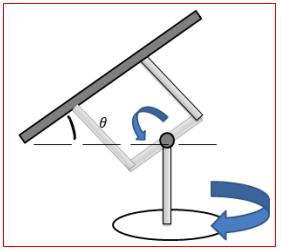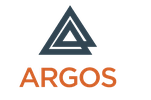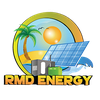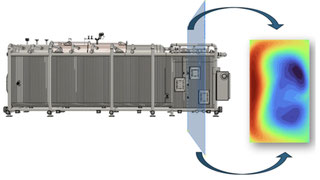Imagine a world where everyone has access to clean and affordable energy.
Can you help make this a reality?
The cost of solar panels has plummeted over the last two decades. So, what’s next? We believe that an innovation in how solar panels track the sun could reduce the cost of solar power worldwide by up to 30%.
Your Challenge - Innovate the Dual Axis Tracker Frame
In its simplest definition, a tracker is used to reposition solar panels to follow the sun with a certain degree of accuracy. The current method to track the sun is to place solar panels on large, automatically moving frames. However, that may not be the way of the future.
Through this challenge, we are seeking ideas and designs from you about how to reinvent the dual axis tracker frame entirely. Perhaps you propose a new material, a new installation method, or a new approach entirely - we leave that up to you. All you have to do is improve the status quo.
Solar Trackers Today
Solar trackers are one of many ways to mount solar panels. Coincidentally, they are also among the most efficient forms of mounting equipment available. Since they “track” the sun’s position in the sky, they’re able to maximize the energy received from the sun throughout the day, rather than being locked into a single position that becomes less efficient as the sun’s angle changes, sacrificing optimal energy production for part of each day.
Fixed-Tilt System
See Figure 1 for an example of a fixed-tilt set up for solar panels. Here, the module is stationary at this angle at all times. The value of the angle is equal to that of the latitude of the location where the panels are to be used.

Figure 1
Single Axis Trackers
In order to maximize the panels’ exposure to the sun, single-axis trackers were created. Single-axis trackers rotate at their base to mimic the sun’s path through the sky as it moves from East to West. Single-axis trackers have been known to improve output by more than 27-32% of the output of fixed-tilt systems. See Figure 2 for an example.

Figure 2
Dual Axis Trackers
Unsurprisingly, dual-axis trackers operate similarly to single-axis trackers, but with two axes of movement, aligned with North-South and with East-West, giving them a wider range of position options. As seasons change and the sun’s path goes from low in the sky in winter to high in the sky in summer, dual-axis trackers can optimize the amount of solar energy captured. See Figure 3.

Figure 3
The strength of dual-axis trackers is their ability to maximize energy production. However, this is the status quo. They also have a higher degree of mechanical complexity, making them more expensive and requiring more maintenance over their installed lifetime. As such, single-axis trackers are more commonly used, as the cost of dual-axis trackers is significantly higher than single-axis, while only showing marginal improvement in energy production (3-8% more than single).
Components of a Dual Axis Solar Tracker
- Tracker Mount Frame
- The skeletal holding of the solar panel upon which the panel is placed in a proper inclined position, attached to a post
- Drives
- Used to control the rotation of the motor shaft based on the load
- Sensors and Sensor Controllers
- Used to detect relevant parameters induced by the sun to then manipulate the controller which then yields outputs
- Motor and Motor Controller
- A motor converts electrical energy into mechanical energy
- A controller ensures that correct amount of current is given to microcontroller and motor
- Tracker Solving Algorithm
- The computer or a processor calculates the sun’s position from algorithms using its time/date and geographical information
The Opportunity
Every telescope on the market that can track a planet has improved, the motors have gotten smaller, the price has dropped, and the accuracy has improved. No comparable innovation has occurred in trackers, because the price of solar panels themselves was so high that there was no reason to innovate the trackers. However, the cost of solar panels now is the same or less than the price to manufacture trackers, so we believe it is the perfect time to innovate.
Previous innovations in the software used to track the sun have dropped costs up to 20%, but we see this as linear progress when we believe the opportunity is truly exponential. Current tracker manufacturers will tell you that 80-90% of the cost of trackers today is due to the price of steel, which is out of our control. Therefore, proceeding with the status quo will result in little progress. This is your opportunity to propose a new methodology, material, or infrastructural design and be selected as a finalist to develop a proof of your concept.
The results of this competition will be an immediate drop of one-third of the cost of solar, worldwide. We see that as a significant impact on the world. Accept this Challenge today, and join us in taking a true step toward abundance through energy independence.
Challenge Structure
Phase I: Ideation
- Submit your idea for how to innovate the physical infrastructure of the dual-axis tracker
- Up to 3 ideas will be selected to receive a cash award to fund the development of a proof-of-concept.
Phase II: Design
- Turn your idea into a full design supported by thorough descriptions, visuals, and a proof of concept
- Up to 2 ideas will be awarded cash prizes and have an opportunity for a manufacturing contract
About RMD Energy
In the past solar energy simply cost too much for most people and storage simply wasn’t practical. But times have changed. Our integrated systems allow you to focus, concentrate and catch solar energy during the day, keep it in an ultra-efficient 112-yearLTO storage bank, and charge as needed from a variable speed genset.
From telco tower to homes, resorts to the grid it means huge savings versus traditional power distribution. Most people outside the largest cities will see savings of 40-50% from their monthly power bill.
Best of all, you don’t pay for equipment, we lease you a system tailored to your energy needs.
What Can You Do Right Now?
- Click “Follow” to receive Challenge Updates and be the first to hear when this challenge is launched!
- Share this challenge on social media using the icons above. Show your friends, your family, or anyone you know who has a passion for discovery.
- Start a conversation in our Forum to join the conversation, ask questions, or connect with other innovators.

Guidelines
The Prize
RMD Energy is committed to awarding up to $60,000 in overall prize money:
- Phase I: $20,000
- Up to 3 Finalists: $5,000 each to fund the development of their Phase II entry
- 5 Novel Idea Awards: $1,000 each to the most innovative or original ideas
- Phase II: $40,000
- Grand Winner: $30,000 and potential commercial contract
- Runner-Up: $10,000 and potential commercial contract
Challenge Structure
Phase I: Ideation Round
What you need to do: Submit your idea on how to move a solar panel to track the sun.
Who can participate: We welcome experts and non-experts by giving large awards to qualified submissions that can be reduced to practice, intended to be the model for future manufacturing, and smaller awards to creative ideas that spark new innovation.
What you can win: The Judging Panel will select up to 3 finalists who will receive $5,000 and any necessary feedback in order to pursue their Phase II proof-of-concept design. Additionally, RMD will select up to 5 Novel Idea Winners to receive $1,000 each.
What happens next: This is a non-elimination round. While only 8 entries will receive cash rewards, all teams are welcome to advance to Phase II.
Phase II: Proof-of-Concept Round
What you need to do: Develop your idea into a robust design
- Submissions must include a proof of concept to convey that the design has been reduced to practice and is intended to be used as a model for future manufacturing
- Proof-of-Concept can be done on a 3D-modeling software program or a prototype can be built. If no CAD design is submitted, competitor must include thorough justifications that are intended to prove viability to the Judging Panel.
Who can participate: Anyone can enter Phase II. You do not need to submit a Phase I entry to participate in Phase II.
What you can win:
Cash
- The Judging Panel will select the Grand Prize Winner to receive up to $30,000 USD and the Second Place Winner to receive up to $10,000 USD.
R&D Funding
- If RMD Energy determines that either winning concept is not “production-ready,” RMD may opt to fund additional steps of research and development to reach a mutually agreeable product.
Royalties
- Once the winning solution(s) reaches a production-ready level of design, the inventor agrees to extend an exclusive license to RMD, in exchange for a 5% royalty on each unit manufactured and sold. Agreement exclusivity will expire within 4 years of the date the agreement is formed, if RMD has not shown interest in the form of at least 200 units ordered and produced within 4 years.
Manufacturing Contract
- Should the winning innovator be in a position to manufacture their technology at scale, the innovator may opt to enter a manufacturing contract with RMD Energy instead of extending an exclusive license. The innovator must prove they have the resources, capital, and expertise to produce functional trackers at scale in under two years.
How Do I Win?
To be eligible for an award, your proposal must, at a minimum:
- Satisfy the Minimum Eligibility Criteria
- Satisfy the Judging Criteria
- Thoughtfully address the Submission Form questions
- (Phase II) Submit a Proof of Concept of your tracker design
Minimum Eligibility Criteria
At a minimum, trackers must be able to:
- Move a flat surface with the dimensions of 6 meters (width) x 4 meters (height)
- Move a flat surface weighing 1056 pounds (480 kg), evenly distributed (20 kg/m2)
- Follow the sun with a precision of .5° accuracy from 10° above sunrise horizon through midday and down to within 10° of sunset location
- Function from locations from 65° N to 65° S
- Function in 3 defined zones:
- North of 23° N
- Between 23° N and 23° S, and
- South of 23° N
- Withstand winds up to 18m/s (40MPH)
- Stow in winds greater than 18m/s (40MPH)
- Withstand salt air corrosion and invasive insects/lizards
- Function in temperatures 0°- 45°C
- Function in humidity ranges from 5-90%
Judging Criteria - Phase I and Phase II Awards
Additionally, entries that can satisfy all minimum criteria will then be ranked according to the additional judging criteria below.
|
Metric
|
Description
|
Weight
|
|
Viability
|
Is the solution possible to build and install? Does the innovator adequately justify their claim that the proposed solution is viable?
|
30
|
|
Cost
|
Does the innovator provide adequate raw material and product weight details? Does the solution propose a method or material that will significantly reduce the current cost?
|
20
|
|
Installation
|
Does the innovator accurately account for how many man-hours are required to install one frame? What machinery or equipment is required for installation? Does the solution propose a method or material that will significantly reduce the current cost?
|
20
|
|
Durability
|
Does the innovator thoroughly address and justify how the frame will withstand external conditions including wind, humidity, heat, and corrosion? Does the solution exceed the minimum eligibility standards listed?
|
15
|
|
Innovation
|
How does the proposed solution differ from existing solutions addressing this problem?
|
15
|
|
Total
|
|
100
|
Judging Criteria - Phase I Novel Idea Awards
The Novel Idea Awards will grant $1,000 each to the 5 most innovative or original ideas submitted in Phase I. We recognize that great ideas may not be fully technically or physically viable, however, they may serve as a catalyst to spark a design idea that can develop into true viability. Here is how we will judge the Novel Ideas:
|
Metric
|
Description
|
Weight
|
|
Viability
|
Is the solution possible to build and install? Does the innovator adequately justify their claim that the proposed solution is viable?
|
10
|
|
Cost
|
Does the innovator provide adequate raw material and product weight details? Does the solution propose a manufacturing method or material that will significantly reduce the current cost?
|
10
|
|
Installation
|
Does the innovator accurately account for how many man-hours are required to install one frame? What machinery or equipment is required for installation? Does the solution propose a method or material that will significantly reduce the current cost?
|
10
|
|
Durability
|
Does the innovator thoroughly address and justify how the frame will withstand external conditions including wind, humidity, heat, and corrosion? Does the solution exceed the minimum eligibility standards listed?
|
10
|
|
Innovation
|
How does the proposed solution differ from existing solutions addressing this problem?
|
60
|
|
Total
|
|
100
|
Rules
Participation Eligibility:
The challenge is open to all adult individuals, private teams, public teams, and collegiate teams. Teams may originate from any country. Submissions must be made in English. All challenge-related communication will be in English.
No specific qualifications or expertise in the field of solar, renewable energy, or industrial design is required. Prize organizers encourage outside individuals and non-expert teams to compete and propose new solutions.
To be eligible to compete, you must comply with all the terms of the challenge as defined in the Challenge-Specific Agreement.
Registration and Submissions:
Submissions must be made online (only), via upload to the HeroX.com website, on or before the submission deadline (see challenge timeline). No late submissions will be accepted.
Intellectual Property Rights:
If an innovator is selected as the first place winner in Phase 2, the innovator must agree to provide access to their technology in the form of a licensing agreement or receive a stake in a commercial enterprise in exchange for use of their technology. Exact terms will be mutually negotiated. Notwithstanding granting the Challenge Sponsor license for the submission, as noted above, Finalist retains ownership of the submission.
Selection of Winners:
Based on the winning criteria, prizes will be awarded per the Judging Criteria section above. In the case of a tie, the winner(s) will be selected based on the highest votes from the Judges.
In the case of no winner, RMD Energy reserves the right to withhold the Prize amount. In place of the original prize amount, RMD Energy must issue a Consolation Prize to the team or individual closest to the winning solution in the amount of at least 10% of the total original prize purse.
Additional Information
- By participating in the challenge, each competitor agrees to submit only their original idea. Any indication of "copying" amongst competitors is grounds for disqualification.
- All applications will go through a process of due diligence; any application found to be misrepresentative, plagiarized, or sharing an idea that is not their own will be automatically disqualified.
- All ineligible applicants will be automatically removed from the competition with no recourse or reimbursement.
- No purchase or payment of any kind is necessary to enter or win the competition.
- Void wherever restricted or prohibited by law.



















